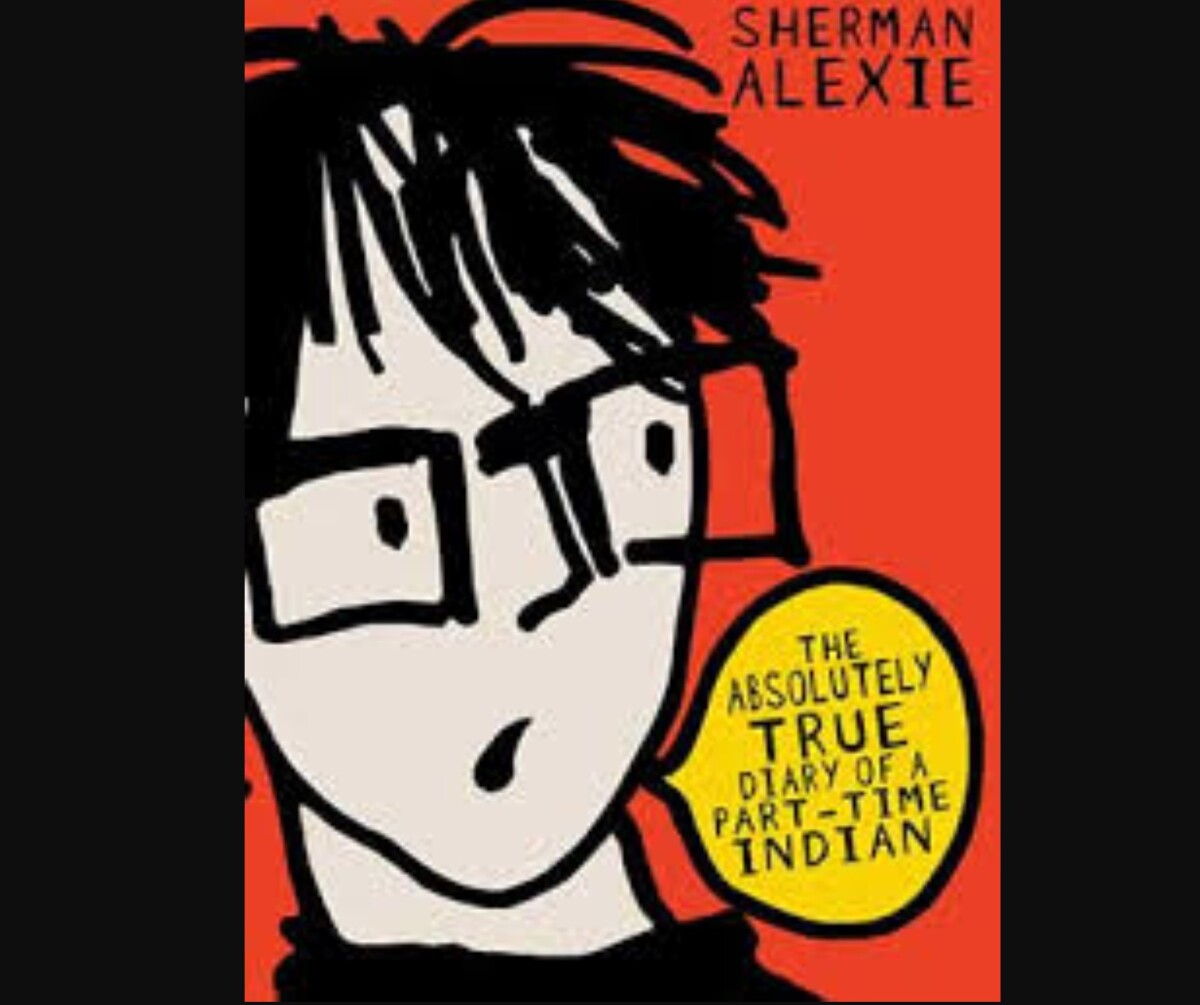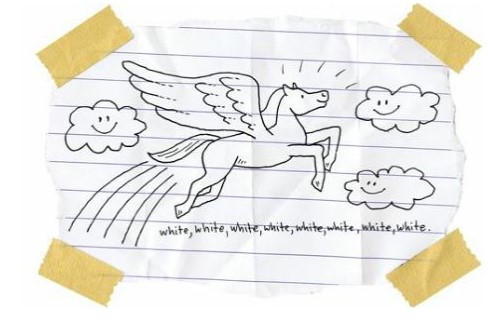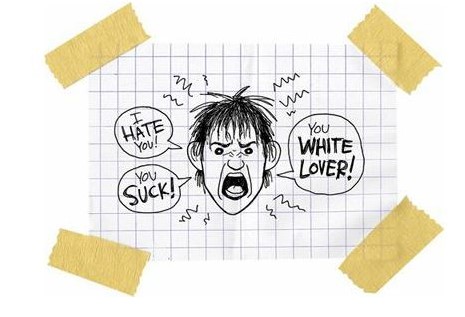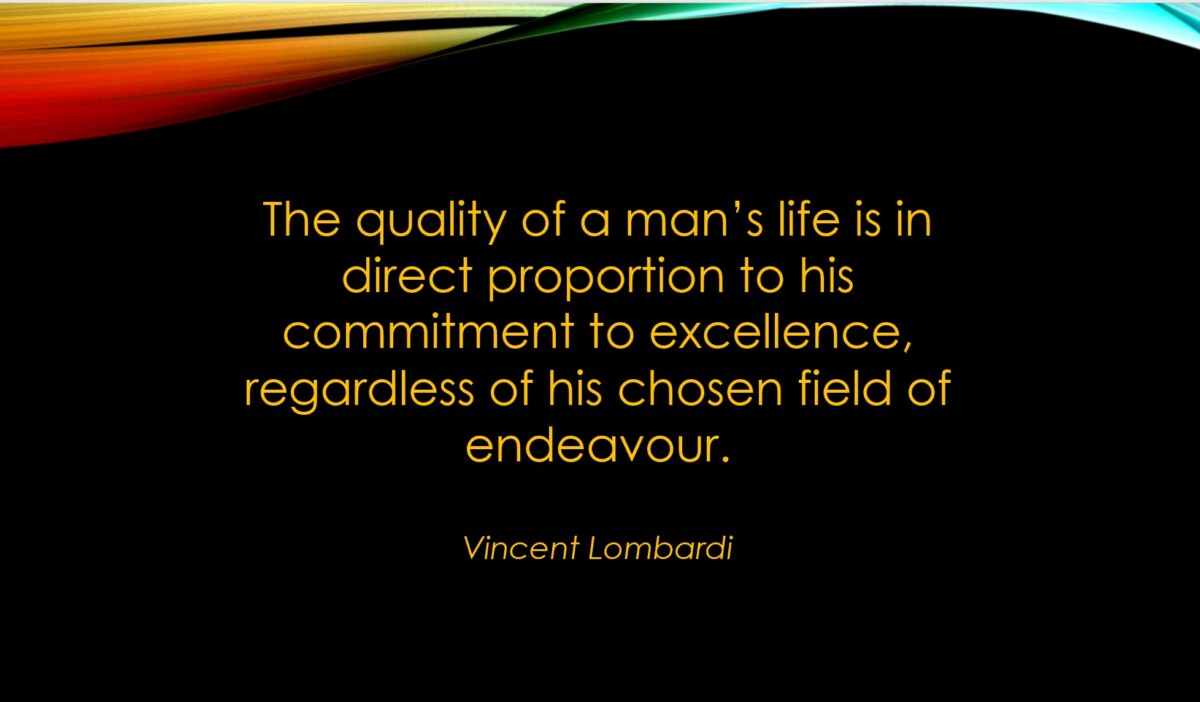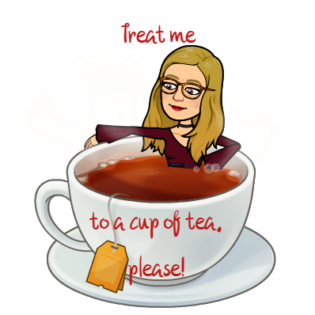
This Theme Page is a Reading Guide to the book The Absolutely True Diary of a Part-time Indian by Sherman Alexie, available in esl-bits.net. Suitable for level A.2.2 – B1. (year 8-9 and above in Sweden)
NB! If a video doesn’t show in your browser, click on the link below to go to YouTube.
Background information: You can learn a lot about Native Americans here
Preview
Chapter 1
Read Chapter 1.
This is what a child born with “water on the brain” may look like.
This image shows what a seizure may entail.
You can also have a look at a vacuum, surgery, vulture, and orbit.
“To be susceptible to seizure activity” means that he could easily get another seizure.
After learning about any new words, you are advised to find them in the chapter to see how they were used. . If you are reading online, you can always search for the word in the text.
Look at Junior’s first drawing of himself. Check his
- ten extra teeth pulled out
- lopsided eyes and glasses
- enormous skull
- pencil body
- huge hands and feet
- stutter and lisp
Watch First Aid in Seizures in case you’ll ever see anybody having a seizure.
Listen to what the people in the video below say about the word ‘reservation‘ or “rez”, as Junior calls it.
All questions can be either discussed in class or written about as an assignment:
- What were you thinking about the book after the very first paragraph? How did your thinking change towards the end of the chapter?
- Read the last sentence of the chapter again. Junior uses a lot of figures of speech in his story. What do you think he means with the “dams and floods” and why does he call his cartoons “lifeboats”?
- There are many more figures of speech in the first chapter and throughout the book. You could start writing the best or funniest ones down.
Reservation | Native Americans | One Word | Cut – YouTube (3:08) Cut invites people from different groups to weigh in on one word–and their responses show us just how complicated and unique we all are.
Chapter 2
Get acquainted with the Spokane Tribe on their website. Read about their history.
Take a look at what Kentucky Fried Chicken has to offer.
A mutt is a mix-breed dog and a stray one walks around with no apparent owner.
Junior calls himself an Indian. Think about what you would call him before watching this video:
‘Indian’ or ‘Native American’? – YouTube (1:27) What to call the aboriginal peoples of North America?
Chapter 3
Take a look at some teepees, and watch the video below to learn about a Powwow.
You can also have a look at a shovel and male Indian braids, and find out what hydro- means.
These are the cartoons Rowdy liked: Richie Rich and Archie and Casper the Friendly Ghost.
Questions to think, talk, and write about:
- What do you know about Junior’s family by now?
- Why do you think Junior and Rowdy are inseparable?
As Long As We Dance – YouTube (3:52) “The drum is the heartbeat of the Indian people. You can feel it in your feet and it moves through your body and you can just feel it in your soul.”
Chapter 4
Take a look at some isosceles triangles, a womb, and a trailer of The Sopranos.
You can also find out what varsity, ambidextrous, and Witness Protection Program mean.
Questions to think, talk, and write about:
- What you can learn about Junior’s sister, by looking closely at her picture.
- In the last paragraph and the picture below, Junior tells a story without the exact words. Make sure you understand what’s happening before starting the next chapter.
Chapter 5
In this chapter, Rowdy’s name is used in a sentence: “When I first started teaching here, that’s what we did to the rowdy ones, you know? We beat them.”
Watch the video below to learn about “Kill the Indian, save the man“.
See some covers of the kind of novels Mary wanted to write.
Questions to think, talk, and write about:
-
- Why did Junior throw the book?
- What reasons can you think of for Mr P’s visit?
Kill the Indian, save the man – YouTube (2:24) …to help raise awareness to the history that’s not taught in schools, to honor the ancestors that survived and ones that crossed over during this period of Indian history.
Chapters 6-7
See the maps of Washington State and Spokane Reservation. Hunters lies northwest, Springdale northeast, and Reardan southeast of the reservation.
Learn about the first line in The Tale of Two Cities.
Questions to think, talk, and write about:
- Can you think of a reason why the other Indians would hate Junior for transferring to Reardan?
- What does the mentioning of The Tale of Two Cities tell us about Junior?
- Look at the picture in the middle of Ch 7 and explain Junior’s hope.
- See the picture at the end of Ch 7. Can you find a clue to the first question above?


Chapter 8
Look at Reardan School’s Website. They have recently deleted the mascot from the page.
Questions to think, talk, and write about:
- Look at the map of Spokane Reservation again and explain this: “I felt like a magician slicing myself in half, with Junior living on the north side of the Spokane River and Arnold living on the south”
- What are the “fistfight rules” in your culture?
- Why do you think Reardan School has deleted the mascot from their website?
Chapter 9
See what a farm tractor, combine and grain truck look like
Check what it means to be an alpha dog.
If you read carefully the information about Grandmother around the picture of her, you’ll learn that she makes beaded keychains to sell on eBay. She calls them “Highly Sacred Aboriginal Transportation Charms.” Learn about the American Indian beading tradition in the video below.
Questions to think, talk, and write about:
- What do you think would have happened if Junior had just walked away from the bully?
- Was Grandmother right?
- How would you have handled the situation with the bully?
- Roger called the motorbike ‘vintage‘. Discuss the different values Roger and Junior might have had for the Dad’s friend’s old motorbike.
- Why does Penelope pretend not to recognize Junior?
Native American Beadwork – YouTube (2:20) After beads were first introduced to the Native Americans by the Europeans in the 16th century, they became a staple of Native American art.
Chapters 10-11
Take a look at an otter and an Indian warrior.
Questions to think, talk, and write about:
- Have you ever been ‘trick or treating’? If you have, talk about it. Did you have costumes? When, where and with whom did you do it?
You can learn a lot more about Halloween here.
Chapter 12
Take a look at some zombies, zits, and petrified wood.
Check what these words mean: articulate, suffocate, bubonic plague
Remember that after learning about any new words, you are advised to find them in the chapter to see how they were used. If you are reading online, you can always search for the word in the text.
Trading posts are like Indian shops.
Many Indian reservations have casinos. You can learn more about them in the video below.
Find the Flathead Indian Reservation and St. Ignatius on the map.
Questions to think, talk, and write about:
-
- Chapter 12 is the longest one so far. It could easily be divided into three parts. Where would you divide it and what would you call each part?
- Look at the title of chapter 12: ‘Slouching Toward Thanksgiving’. Why do you think the author made this into a long chapter?
- Think about the pros and cons of running a casino on an Indian reservation.
“PWNA Indian Casinos – Easy Money Or Not What You Think MASTER – YouTube (2:24/5:31) The beauty and majesty of Native American reservations are masking a harsh reality.
Chapter 13-14
Find the words to ‘secede’ and ‘a suite’ in the text and see how Mary explains them.
Learn to pronounce the word ‘suite‘.
Have a look at some Indian fry bread.
You can learn the true story of Thanksgiving in this video. Use the CC subtitles.
The First Thanksgiving: What Really Happened – YouTube (stop at 4:06) An educational animation that tells the in-depth story surrounding the first “thanksgiving”. Use the CC subtitles.
Chapter 15
Check the meaning of scintillating, cinnamon, mutated, and smudge
If you’d also like to know the difference between anorexia and bulimia, you can watch this video about bulimia or scan through this article.
Questions to think, talk, and write about:
- Why do you think Penelope chose to date Arnold?
Chapter 16
Read and/or listen to Chapter 16 (3:58)
Questions to think, talk, and write about:
- Can you understand and explain why Gordy called Arnold racist for loving a white girl?
- How was Gordy’s answer similar to Rowdy’s?
Watch this video to understand the dilemma.
What Would You Do: Woman introduces Native American fiance to white parents Video – ABC News (7:50) If you saw this happening, what would you do?
Chapter 17
Questions to think, talk, and write about:
- In this chapter, the author reveals the name of the book. Can you explain it now?
- Look at the comic strip with five ways to answer if you are poor. Think about something sensitive that someone might ask you. How would you answer?
- The chapter is called ‘Dance, dance, dance’. After the first dance is over, what are the other two (or more) ‘dances’ that Arnold gets this night? (Think metaphorically.)
Chapter 18
Check the meaning of being repressed,
What were the three different words used for somebody’s backside?
Check what these words mean: a preditor, starvation, and to banish
Remember that after learning about any new words, you are advised to find them in the chapter to see how they were used. If you are reading online, you can always search for the word in the text.
Questions to think, talk, and write about:
- Explain why some Indians called Junior ‘an apple’.
- What was Gordy trying to say that Arnold did not understand?
- Are there any similar struggles in your life?
Chapters 19-20
Just a reminder of what varsity means.
Learn to know about Vince Lombardi by watching this video (3:17).
Questions to think, talk, and write about:
-
- Can you decipher the name of the virus in the blue picture? Why is it spelt like that?
- Discuss what Lombardi’s quote below would mean in your life: “The quality of a man’s life is in direct proportion to his commitment to excellence, regardless of his chosen field of endeavour.”
Chapter 21
The Christmas song with a ‘Partridge in a Pear Tree’ is actually called ‘12 days of Christmas‘.
Watch this video about the common view of alcoholism among the Indians:
UA study shows the perception of binge drinking Native Americans isn’t reality – YouTube (2:23) Popular culture often depicts Native Americans in a negative fashion. A University of Arizona study finds this has little evidential backing.
Chapter 22
Do you want to know the size of the Grand Canyon?
Check the meaning of being eccentric, sacrifice, and invisible.
Learn when Mountain Gorillas were first found.
Questions to think, talk, and write about:
- Do you know somebody who is really tolerant? Describe that person.
OR What does tolerance mean to you?
Chapter 23
Learn what a wake is.
Have a look at some Powwow dance outfits.
Listen to an Indian Mourning / Memorial Song below; the kind that Mary probably would be singing on the day of the funeral.
Memorial Song – YouTube (1:59) Memorial Song · The Native Tribes United – American Indian Chant
Chapter 24
Look up the word ‘grief’ in different dictionaries (easiest online), like Junior did, and choose which definition you prefer.
See, who Euripides was. You can also read or watch a video (6:35) about his play Medea.
Something to think, talk, and write about:
- Make a list of the people/musicians/foods or books that have given you the most joy in your life.
Chapter 25
Check the meaning of a totem pole, an egomaniac, to be burned at the stake
Learn about the Indian scouts who led the U.S. Cavalry against other Indians in the video below
If you are into basketball, you can listen to this news report (5:24) discussing the Red Lake Warriors, an all-Native American basketball team, 1998.
If you don’t know the story of David and Goliath, you can learn about it here (2:11).
Questions to think, talk, and write about:
- Why did Junior/Arnold feel like an Indian scout?
- How did Arnold feel after the game and why?
- How did Junior feel after the game and why?
Fort Verde: The Indian Scouts – YouTube (3:25/9:51) The U.S. military used Native American Scouts in its southwestern operations. This video introduces the history of Indian Scouts and their relationship to Fort Verde State Historic Park, in Camp Verde, Arizona.
Chapter 26
Beware of the American meaning of the word faggot.
Questions to think, talk, and write about:
- What’s the contradiction between the title and the chapter?
- How could you interpret the title still to be true?
Chapter 27
Learn about Leo Tolstoi (2:23) and the opening sentence of his book Anna Karenina
See what a cantaloupe looks like.
Something to think, talk, and write about:
- Look at the picture at the end of the chapter and explain how you understand it.
Chapter 28-29
Something to think, talk, and write about:
- What was the big realization that made Junior/Arnold know that he was going to be okay?
Chapter 30
Read and/or listen to Chapter 30 (25:09)
Something to think, talk, and write about:
- How was the very last sentence meaningful? “We didn’t keep score.”
After Reading
If you google “an absolutely true diary of a part time indian trailer“, you get several examples of book trailer videos made by other students. These may inspire you to make your own, either by yourself or with some friends.
About the Author
Meet Sherman Alexie- YouTube (2:54) “When you find a book about abuse or any topic of pain that you so identify with, I mean, it becomes the most reliable friend you can have because a book is always going to be there,” muses Sherman Alexie.
Sherman Alexie – Backstage – YouTube (5:55) Sherman Alexie is a poet, short story writer, novelist, and performer who has won a PEN/Hemingway Citation for Best First Fiction, and the National Book Award for Young People’s Literature.
About the Natives
The Natives and the English – Crash Course US History #3 – YouTube (11:26) John Green teaches you about relations between the early English colonists and the native people encountered in the New World.
CC

This work is licensed under a Creative Commons Attribution-ShareAlike 4.0 International License

